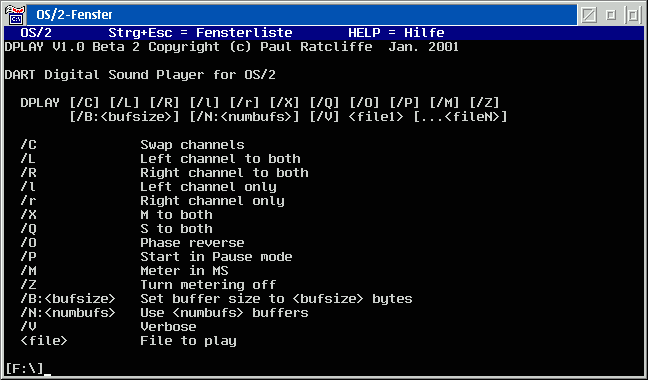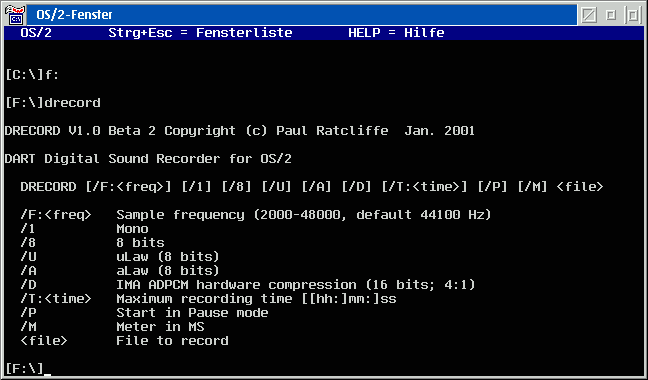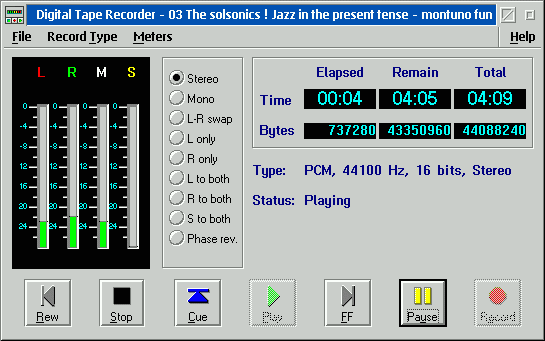
VOICE Homepage: http://www.os2voice.org
[Previous Page] [Next Page]
[Features Index]]
 VOICE Homepage: http://www.os2voice.org |
[Previous Page] [Next Page] [Features Index]] |
|
Article by: Klaus
Staedtler von Przyborski © April 2001 Translator: Heribert Bieler |
Recently, I had a somewhat strange experience. I was in a second hand shop -where
I purchased an electronic Braun alarmclock radio for a very good price (Millenium
Edition- seems to be not as many buyers for this as for the other ME, but in contrast
to the other ME, which I remove from the computers of my clients, without regret).
While there, I found a stack of computers in a back room. Looking closely at them,
I recognized these as servers from Compaq, HP, IBM and Siemens. It was a sad sight,
to look at these previously high performance computers, lying about carelessly and
dirty. Two IBM PC-Server were quite clean and opened, so that one could see their
splendour. Mylex SCSI-Raid cards with their own Intel i960 Processor with EISA-Bus
were visible; in addition Dual-Processor-Boards, and ECC-Ram were there, i.e. everything
that is nice and expensive (I mean was expensive). I asked about the price
for these and got the answer: 500 - 900 ATS (which is about $32, to $58, USD) depending
on type; unchecked, with no guarantee, that is "as is." I could not believe
it. Well they are old, had only two Ultra-SCSI hard disks with together only 4 Gbytes,
Pentium PRO-Processors and 32 MB Ram., But nevertheless , I couldn't believe the
loss of value that occurs within such a short time period.
However, I succceeded in finding a new use for four IBM PC-320 Servers, partly
because of the additional PCI slots and the sure knowledge that they work under
OS/2. Two of them will earn their "money" in the future as backup-server
for systems running under Linux. To be on the safe side I bought four servers,
to make sure of getting two of them running. With a little bit of luck, they will
each have 64MB Ram and two Pentium 133 Processors.
The reason I'm telling you all this is because I was forced to exchange my defective
motherboard (Asus PB3F). At least at that time, it was not possible to find a slot-1
equipped board, and I decided in addition (after one year of operation) to buy a
new processor. Given the prices for memory, I upgraded the system to 256MB (Linux
with KDE 2.0 runs quite well now).
But software experience is no better than hardware i.e.: every year a new operating
system, after Windows 2000 we will have 2001 - excuse me XP - after Corel Draw 9
a Corel Draw 10 with even more bugs ...
Actually, regarding software you do not have to follow this trend, because software
does not get older and sometimes this even has advantages. One of my friends
used to work with Word 4.0 and wanted to continue definitely in that way; even after
purchasing a new computer (the old one was from 1987 and it seemed it was close
to falling apart). I recommended OS/2 because of the DOS-support and offered to
answer her questions in case of problems. The single question, I got was:
"The computer does not make intermediate saves". I: "Why ?"
She: "Well, when I push save, I do not have to wait". Just to avoid confusion,
the computer saves.
But before I continue to praise old hardware and applications, lets talk about
some news.
At the time I was not totally satisfied with SBLive! particularly with the available
drivers, I looked for an alternative and found it in the form of Terratec DMX X-Fire
1024. This contains a Crystal Chip and therefore works with Crystal-drivers. As
mixer the LBMix
- described in the last issue - is suitable and even without applying the pipe-solution.
Let me suggest a comparison between these two cards now. As far as hardware is
concerned, these two differ not at all (purely personal view and not result of a
test).
SBLive:
+ Wave perfect
+ Flash/2 functioning
+ RTMidi
+ 32Bit KEE-driver (for Warp 4.5)
- not completely conforming to IOCrtl, (e.g. mixer function via pipe only, applications
with integrated mixer do not work).
- no WIN-OS/2 support
- no FM-MIDI
Terratec DMX X-Fire 1024
+ 100% conformance to IOCrtl 90
+ WIN-OS/2 supported
+ FM-MIDI and RTMIDI
+ 2. CD-input operating
- Flash/2 does not work
- frequent 'clicks' at beginning and end of events
- the use of Pause causes sometimes 'Stammer' of output, esp. in case of MP3-files.
Unfortunately I cannot make any statements for the SPDIF-input / output because
I don't have suitable hardware.
For both cards I have some good news: Timur Tabi intends to improve the SBLive!-driver
and the Flash/2-Team will correct the Bug for the Crystal driver. Presently I prefer
Terratec, but this might change depending on the driver situation. For safety I
will keep the SBLive! in my hardware archive.
Then a new version of Audio/Data-CD-Creator
(version 0.46) and a new version of CDRECORD
(version 1.10a15) by Chris Wohlgemuth appeared. With this situation two nasty (but
rather cosmetic) bugs disappeared. CDDA2WAV produces no trap at the last piece,
when all files have been selected for grabbing and a "racing condition"
has been removed. The use of CDDB for naming WAV-files causes absolutely no problems.
Since developers of CDDB now require payment for the use of the data bank, this
data bank should not be used any more, at least it will not work in the future,
rather than selecting FREEDB in the properties
only. Furthermore one can use in case of two audio projects two CD-Recorders simultanously,
this - however- requires the driver ASPIROUT
V 1.1beta4 by Paul Ratcliffe, and a few extensions have been added. For example
you can call now the OS/2-native audio editor via context menu and the toolbar has
a free Drag & Drop-button. Simply drop an application of choice onto it and
you can open it directly from AUDIO/DATA-CD-CREATOR.
Some time ago I found by accident a new Linux-application, NORMALIZE
by Cris Vaill. This offers the possibility to convert the level of a recording onto
a desired one (e.g. the maximum permissible for CDs). Chris Wohlgemuth, who already
has experience with porting Unix-applications to OS/2, offered kindly to port it
to OS/2.
Of course a tool such as NORMALIZE is not necessary, if you want to produce a
complete 1:1 copy of a CD. But if you compose a CD from different sources, then
NORMALIZE is a tremendous relief, if you want to avoid to adjust the receiving level
after each new piece. Nevertheless, you should use it with care, since neither will
new bits be generated nor will the quality of transformation improve; the opposite
seems to be true.
The first ported version 0.42 did work, but too many "Clippings"
occured with standard values. The successor 0.51 offered the option --peak,
which avoids a clipping, but it had bugs. From 0.52 on, it seemed to be good enough
to release it for OS/2.
After some tests the following seems to be useful:
normalize --peak *.wav sets the maximum
level.
normalize --amplitude=0,18 *.wav sets a level,
which is -on average- below -2dB of the max. level.
normalize - m *.wav constructs the average
level of all files to be treated.
Since NORMALIZE is an "intelligent" application and the separation
letter is taken from the system properties, one has to - deviating from the README
- use the separation symbol implemented in the system properties (e.g. --amplitude=0,18,
not 0.18). In German systems this is usually the comma.
And now, finally the brilliant things.
Paul Ratcliffe developed three applications, which I have missed for a long time.
Two of them are VIO applications, DPLAY and DRECORD.

Fig.1: DPLAY.EXE, view of help
DPLAY is a DART- based digital audio-player with some options. At first glance
it is not very exciting. But just give it a file, which exists as an image of an
audio-CD. What other player is able to handle file of 640MB size ?

Fig.2: DRECORD, view of help
DRECORD, also Dart based, is a digital audio recorder with VU-meter etc.
The best in my point of view is, however, DTAPE, a PM-application, which
integrates both VIO-programs.

Fig.3: DTAPE, elements for use
DTAPE should work with all sound cards. I tested SBLive, Terratec DMX X-Fire
1024 and SB AWE64 myself. With all three I had no problems at all.
The advantage of DTAPE with respect to drivers delivered with MMOS/2 are obvious
if you have a look at applications: DTAPE contains a control of the record level
- might be conveniently toggled in between peak level meter and VU-meter -, (remarkable
if you consider discussions in the Seventies about analog technique, which of them
is better suited) - and now DTAPE displays even time and avaliable memory.
Do you miss a button for control of record level ? Well, if Paul Ratcliffe had
implemented it, he would be in some trouble. Dr. Pollack, who also developped a
recorder named MIXER, can tell a story about that. Every soundcard / driver version
has its own implementation of the Mixer-APIs, so it is simply luck, that it works
at all. The missing control in DTAPE is therefor a well chosen limitation, because
if an operating mixer for the sound card exists, then the level control works also
with DTAPE. By the way a peculiar detail: Dr. Pollack did calculate precisely to
me, how a reasonable display of the record level should look like (I drop here for
your convenience technical details), and he made the additional remark, that
this is available under Windows and Linux with the fastest presently available processors
only; under OS/2 a 486 is sufficient. I have absolutely no reason to doubt him.
Any further wishes? For me, yes, the first one has already and kindly been considered
by Paul Ratcliffe within DTAPE. If in the future a Record Next button were
added, that ends the track just recorded and continues with recording track n+1,
or if even an automatic recognition of track recording via detecting pauses (in
between songs) were implemented, I would have no further wishes. Paul Ratcliffe
did even promise, to try an implementation as just described. Needless to say, he
cannot guarantee success and he cannot promise when this might be ready. But anyway,
DTAPE - as it is - is an important step towards a complete OS/2 solution for recording
audio files. Thank you very much, Paul.
A good start (sound cards, LBMIX, DTAPE) and a good final (AUDIO/DATA-CD-CREATOR,
CDRECORD, NORMALIZE in conjunction with a CD-burner) for a complete OS/2-solution
has been made. Actually, what is missing "only", is a wave-editor, that
can handle recording with some errors (e.g. deleting "click" sounds, white
noise, automatically of course would be very nice). With these everything would
be perfect.
Remark: At the time writing this column, I had DTAPE V1.0beta6 as an unofficial
test release. Unfortunately, I cannot give you a source for downloading. You should
keep your eyes open, because if an official release is available, you will notice
it in the usual way (e.g. os2.org, os2bbs, hobbes, comp.os.os2.announce, the VOICE
News list).
Articles referenced:Audio-Data CD-Creator 0.46, Cdrecord/2 1.10a15: http://www.geocities.com/SiliconValley/Sector/5785/index.html |